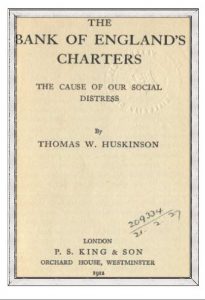A CAREFUL WATCH ON THE EVENTS OF A QUARTER OF A CENTURY has convinced me that the vicious social developments of the nineteenth century were abnormal and were due to an artificial, and therefore removable, cause. That the cause is deep, insidious and subtle goes without saying : had it been obvious it would have been easily discovered.
Nowhere have I seen a full text of Magna Charta, which so illuminates the times of the Normans, save in a translation of a French History of England; the book came from Beckford’s library and was in a fisherman’s cottage. It is curious that in a translation of a Dutch work have I discovered the best historical account of the Bank of England. I refer to Bisschop’s Rise of the London Money Market. But for that work I must have apologized for the slenderness of the early history in this book. Bisschop’s work makes an apology unnecessary ; it is needless to multiply labour: where he leaves off the argument of this book commences.
In chapter iii, part I, Bisschop observes :–
“About this time [1780] the Bank [of England] adopted the unfortunate theory that the note circulation should be contracted simultaneously with an efflux of gold from the Bank, in order to bring about a reflux of the specie withdrawn, owing to the scarcity of circulating medium created by this action. The author of this idea was Mr. Bosanquet.”
It is also noted:
“The theory, as amended [i.e., that the currency should vary with the foreign exchanges], found its way into the Bank Act of 1844.”
